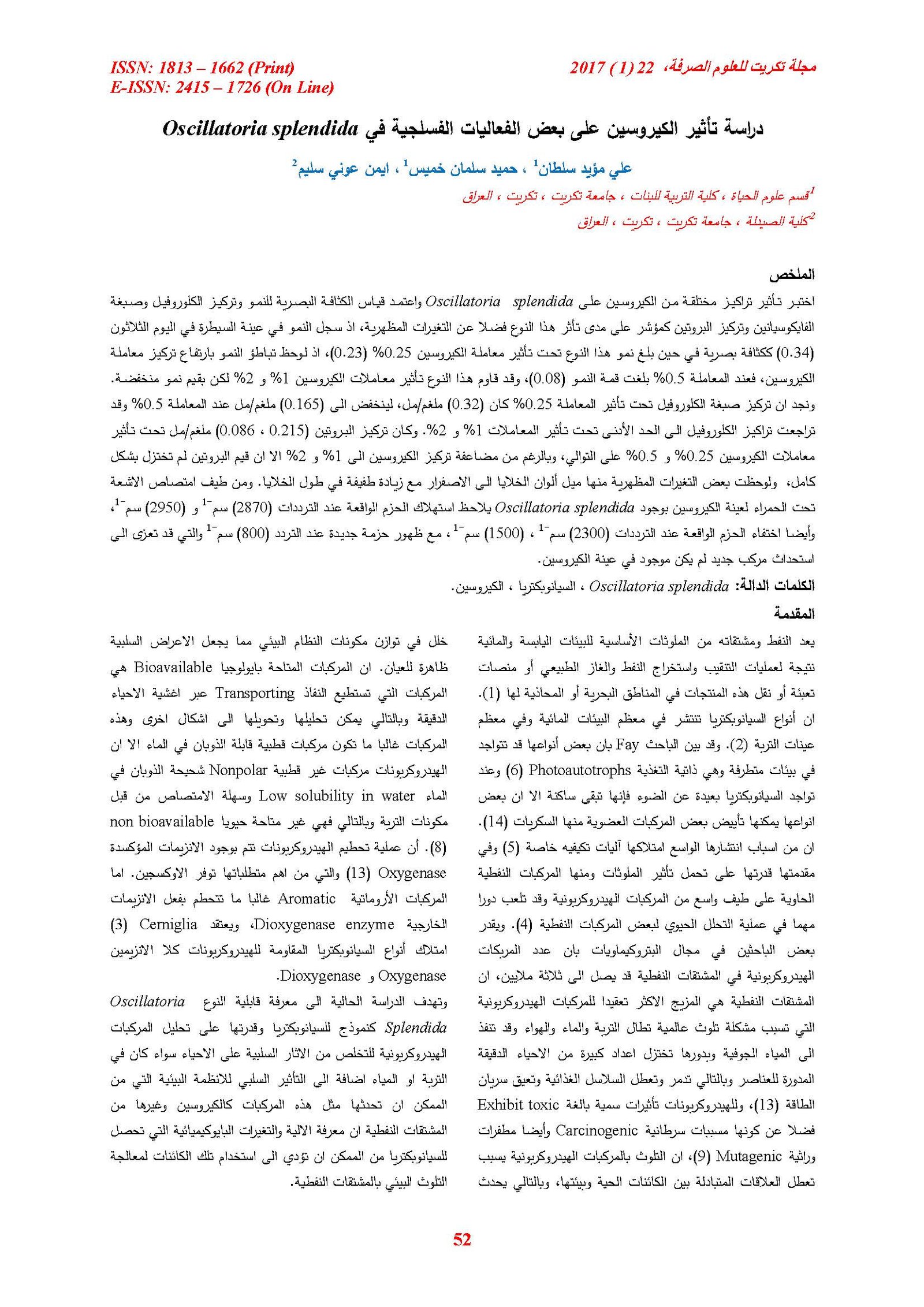Study the effect of kerosene on some physiological activities in Oscillatoria splendida
Main Article Content
Abstract
The effect of different concentration of Kerosene had been examined upon Oscillatoria splendida, The optical density had been depended as measure for growth as well as chlorophyll a concentration, Phycocyanin pigment and protein concentration as an indicator of Kerosene effects, in addition to morphological changes. The optical density of growth in the control sample was (0.34), while it was (0.23) at 0.25% of kerosene concentration, It is noted slowing growth with high concentration of kerosene treatment, at 0.5% peak of growth was (0.08), and resisted the influence of the Kerosene transactions 1% and 2%, but with low growth values. concentration of chlorophyll pigment under effect of 0.25% was (0.32) mg /ml, for as low as (0.165) mg /ml at 0.5% of kerosene, Chlorophyll concentrations have fallen to the minimum under the influence of transactions 1% and 2%. Protein concentration was (0.215, 0.86) mg/ml under the influence of kerosene transactions 0.25% and 0.5% respectively, In spite of the doubling kerosene concentration to 1% and 2%, but the values of the protein did not reduced Completely. Some morphological changes were observed under the effect of kerosene such as yellowing of cells colors with a slight increase in the length of the cells. As well as the absorption spectrum infrared by FTIR show that the Oscillatoria splendida consume many of bundle such as (2870) cm-1 and (2950) cm-1, also the disappearance 2300) cm -1, 1500 cm -1, with the appearance a new bundle at (800) cm-1 Attributed to the introduction of a new compound not found in control sample.
Article Details

This work is licensed under a Creative Commons Attribution 4.0 International License.
Tikrit Journal of Pure Science is licensed under the Creative Commons Attribution 4.0 International License, which allows users to copy, create extracts, abstracts, and new works from the article, alter and revise the article, and make commercial use of the article (including reuse and/or resale of the article by commercial entities), provided the user gives appropriate credit (with a link to the formal publication through the relevant DOI), provides a link to the license, indicates if changes were made, and the licensor is not represented as endorsing the use made of the work. The authors hold the copyright for their published work on the Tikrit J. Pure Sci. website, while Tikrit J. Pure Sci. is responsible for appreciate citation of their work, which is released under CC-BY-4.0, enabling the unrestricted use, distribution, and reproduction of an article in any medium, provided that the original work is properly cited.
References
1- Wodzinski, R. S. and Coyle, J. E. (1974). Physical State of Phenanthrene for Utilization by Bacteria. Applied and Environmental Microbiology, 27, 1081-1084.
2- Whitton, B. A. and Potts, M. (2002). The Ecology of cyanobacteria: their diversity in Time and Space. Kluwer Academic Press, Norwell, MA.
3- Cerniglia, C. E. (1992). Biodegradation of polycyclic hydrocarbons. Biodegradation, Vol. 3: 351-368.
4- Cerniglia, C. E., Gibson, D. T. and Van Baalen, C. (1979). Algal oxidation of aromatic hydrocarbons: Formation of 1-naphthol from naphthalene by Agmenellum quadruplicatum, strain PR-6. Biochem Biophys Res Comm 88: 50-58.
5- Huang, X.D., El-Alawi, Y., Penrose, D.M., Glick, B.R. and Greenberg, B.M. (2004). A multi-process phytoremediation system for removal of polycyclic aromatic hydrocarbons from contaminated soils. Environmental Pollution, 130 (3): 465-476.
6- Dworkin, M., Falkow, S., Rosenberg, E., Schleifer, K., Stackebrandt, E. (2006). The Prokaryotes, Third Edition. Springer Science + Business Media, LLC 4:1053–1073.
7- Fay, P. (1983). The blue-greens (cyanophyta – cyanobacteria). The institute of biology. Edward Arnold. pp. 1-88.
8- Gibson, C. E. and foy, R. H. (1983). The photosynthesis and growth efficieney of a plank tonic Blue Green Algae oscillatoria redke . Br phycol . J . 18: 39-4
9- Plohl, K. and Leskovsek, H. (2002). Biological degradation of motor oil in water. Acta. Chim. Slov., 49: 279-289.
10- Guha, S. and Jaffe, P. R. (1996). Bioavailability of Hydrophobic Compounds Partitioned into the Micellar Phase of Nonionic Surfactants. Environmental Science and Technology, 30, 1382-1391.
11- Juhasz, A. L., Britz, M. L. and Stanley, G. A. (1996). Degradation of High Molecular Weight Polycyclic Aromatic Hydrocarbons by Pseudomanas Cepacia. Biotechnology Letters, 18, 5,577-582.
12- Stanier, R. Y., Kunisawa, R., Mandel, M. and Cohen Bazire, G. (1971). Purification and properties of unicellular bluegreen algae (Order Chroococcales). Bacteriol. Rev. 35: 171205.
13- Singh, A. K. and Gaur, J. P. (1988). Effect of assam crude on photosymthesis and associated electron transport system in Anabaena doliolum. Bull Environ Contam Toxico141:776-780"
14- Lowry, O. H., Rosebrough, N. J., Farr, A. L. and Randall, R. J. (1951). Protein measurement with the folin phenol reagent. J. Biol. Chem. Vol. 75: 193-265.
15- Narro, M. L. (1987). Petroleum toxicity and the oxidation of aromatic hydrocarbons. In: Fay P and Van Baalen (Eds) The cyanobacteria (pp 491-511). Elsevier, Amsterdam.
16- Mackinney, G. (1941) Absorption of light by chlorophyll solutions. J Biol Chem 140: 315–322.
17- Peng, S., Zhou, Q., Cai, Z. and Zhang, Z. (2009). Phytoremediation of petroleum contaminated soils by Mirabilis Jalapa L. in a greenhouse plot experiment. Journal of Hazardous Materials, 168: 1490-1496.
18- Lee, R. E. (2008). Phycology, Fourth edition. Cambridge University Press, New York .p 24 33.
19- Cerniglia, C. E. (1984). Microbial Metabolism of Polycyclic Aromatic Hydrocarbons. Advances in Applied Microbiology, 30, 31-71.Stewart, W. D. (1973). Nitrogen fixation by photosynthetic microorganisms. Ann. Rev. Microbiol. Vol. 27: 283-316.
20- Zachleder, V. and Šetlik, I. (1982). Effect of Irradiance on the Course of RNA Synthesis in the Cell Cycle of Scenedesmus quadricauda. Biologia Plantarum, 24, 341-353.
21- Fay, P. (1965). Heterotrophy and nitrogen fixation in Chlorogloea fritschii. J. Gen. Microbiol. 39, 11-20.Tandeau de Marsac, N. and Houmard, J. (1993). Adaptation of cyanobacteria to environmental stimuli: new steps towards molecular mechanisms. FEMS. J. Microbiology Reviews. Vol. 104: 119-l 90.
